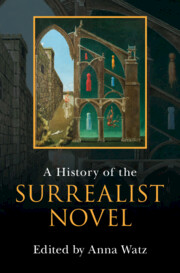Book contents
- A History of the Surrealist Novel
- A History of the Surrealist Novel
- Copyright page
- Dedication
- Contents
- Figures
- Contributors
- Acknowledgements
- Introduction
- I Marvellous Beginnings
- II Transgression and Excess
- III Science, Alchemy, Nature
- IV Transnational Surrealism
- Chapter 16 Nature and Surrealism in the Latin American Novel of the Tropics
- Chapter 17 Surrealism, Existentialism, and Fictions of Blackness
- Chapter 18 Social Critique in the Japanese Post-War Surrealist Novel
- Chapter 19 The World of the Surrealist Novel
- Chapter 20 Feminist-Surrealism in the Contemporary Novel
- Afterword
- Index
Chapter 18 - Social Critique in the Japanese Post-War Surrealist Novel
from IV - Transnational Surrealism
Published online by Cambridge University Press: 02 February 2023
- A History of the Surrealist Novel
- A History of the Surrealist Novel
- Copyright page
- Dedication
- Contents
- Figures
- Contributors
- Acknowledgements
- Introduction
- I Marvellous Beginnings
- II Transgression and Excess
- III Science, Alchemy, Nature
- IV Transnational Surrealism
- Chapter 16 Nature and Surrealism in the Latin American Novel of the Tropics
- Chapter 17 Surrealism, Existentialism, and Fictions of Blackness
- Chapter 18 Social Critique in the Japanese Post-War Surrealist Novel
- Chapter 19 The World of the Surrealist Novel
- Chapter 20 Feminist-Surrealism in the Contemporary Novel
- Afterword
- Index
Summary
With the publication of various translations of French surrealist essays and poems in Japanese avant-garde publications of the 1930s, small groups of writers and individual artists began to make surrealism their own. However, due to the multifarious misunderstandings and often inaccurate adaptations of these texts resulting from their translation into Japanese, the term chō-genjitsushugi (surrealism) expanded to incorporate culturally and regionally specific concerns and concepts. Novelist Kōbō Abe surveyed post-war Japan from a very particular vantage point, having spent years of his life witnessing war and conflict in Manchuria before settling in Tokyo’s metropolis. This chapter examines Abe’s engagement with French surrealism, his frequently black (surrealist) humour, and the quest for the marvellous that manifests across his oeuvre. Writing against the grain of Japanese modernist literary convention, Abe’s surrealism revels in the convulsive beauty of metamorphoses via animal, mineral, and plastic forms. Through the figures of the box, the mask, the dendrocalcalia, or the cocoon of thread, the reader is aligned with narrators who disrupt and critique the order of things, disturbing the surface so as to reveal a sham society that seems hellbent on dehumanizing its citizens.
Keywords
- Type
- Chapter
- Information
- A History of the Surrealist Novel , pp. 313 - 329Publisher: Cambridge University PressPrint publication year: 2023



